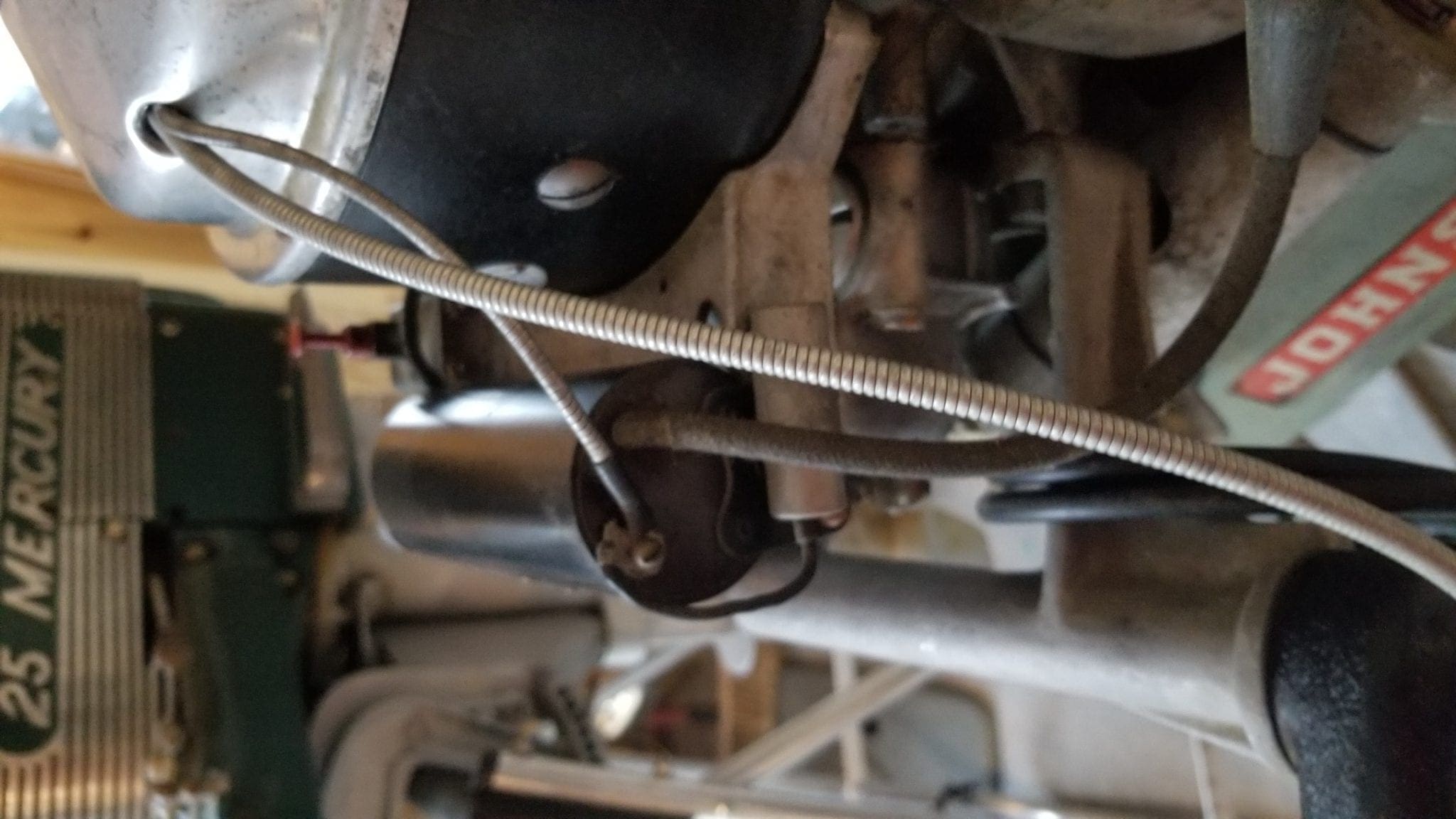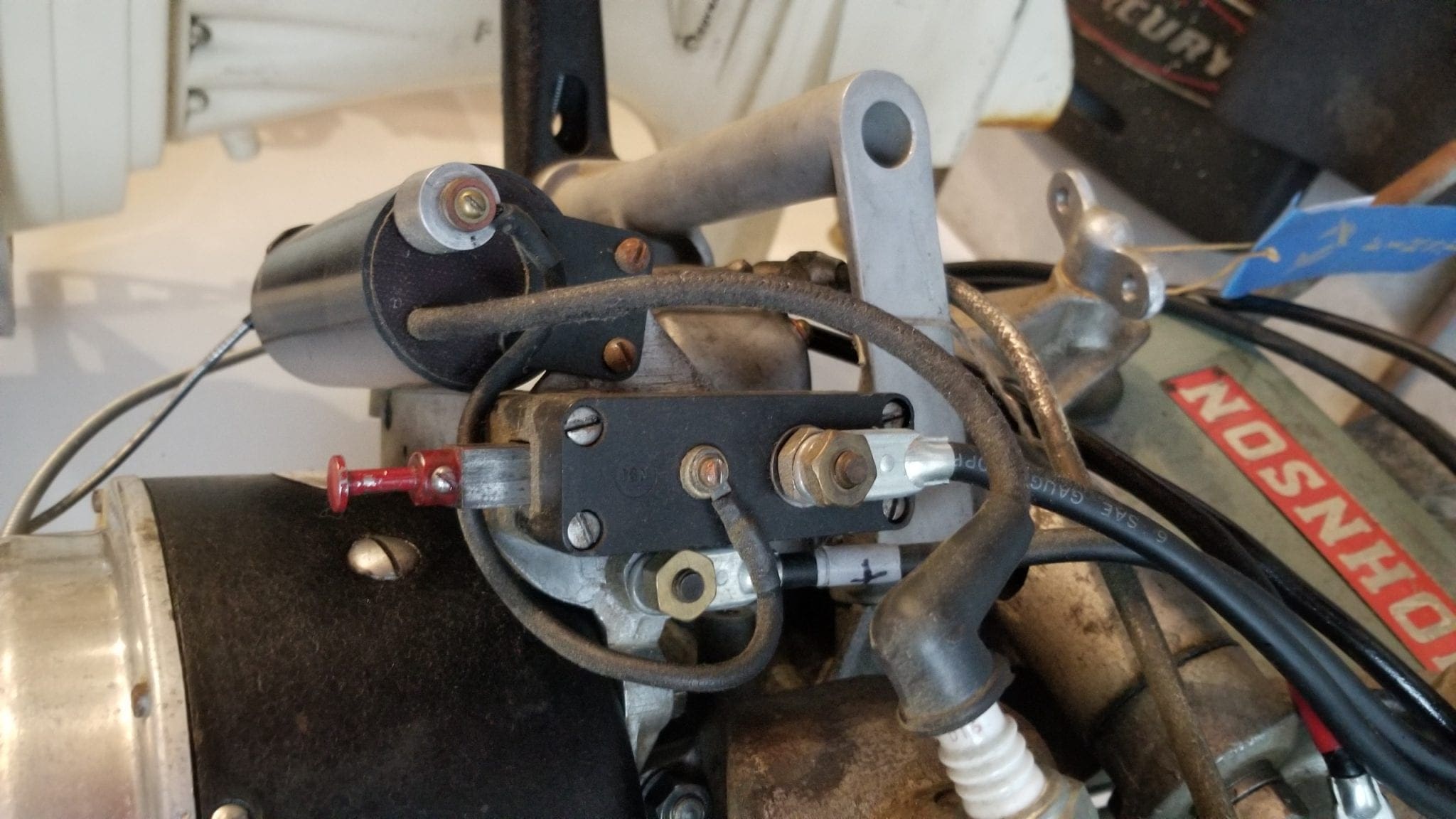Home › Forum › Ask A Member › Owen Dyneto starter generator
- This topic has 29 replies, 5 voices, and was last updated 4 years, 8 months ago by
 tinkerman.
tinkerman.
-
AuthorPosts
-
August 14, 2019 at 8:37 pm #181339
There is one terminal marked field on the starter that’s not used, I’m assuming it was to hook up the sonar lol
It's a jungle out there.
August 15, 2019 at 11:06 pm #18140849morphew I sent you a message
It's a jungle out there.
August 16, 2019 at 9:03 am #181419Hey. I apologize for the late response. I dont get any notice of PMs. I’ll look into that.
I took two more photos for you. As you’re facing the motor on the right side, one wire from the top of armature and one wire from an auto type condenser are connected to small lug on coil. The other wire goes to right side spark plug.As you’re facing the motor on the left side, one wire from large lug on coil to ignition switch. The other wire goes to left side spark plug. The bottom lug on ignition switch goes to negative terminal on battery. The other lug immediately behind ignition switch on coil/starter switch bracket serves as ground and goes to positive terminal on battery. (12v positive ground setup)
I can see the lug you mention on the underside back by gas tank. On my motor there is nothing connected to it.
Hope this helps.
August 16, 2019 at 9:11 am #181423August 16, 2019 at 9:31 am #181426Ok I thought I was on the right track but I’m surely stumped now. I DID NOT know it was a positive ground system and I’m definitely not familiar with this. As I stated earlier the PO had bypassed the switch , probably had his own switch in the boat. He had a red battery cable directly to the lug on the underside of starter (the one you said had nothing attached on your engine) he had the small wire out of top of starter along with the condensor to one lug on coil. The other lug on coil had a field wire that was taped to his positive and ground battery cables and probably ran back to his switch in boat. This one I assume goes to “ignition” terminal on the factory switch. He also had the black battery cable to the ground point beside factory switch. When I started fooling with the motor I just hooked red to positive on battery and black to negative and the starter worked. Do you think mine could be negative ground system? As I said earlier coming out of the top of starter I have 2 small wires one of which went to ground. I just don’t wanna burn something up especially the starter. Ive about got everything else complete and wanna see if it’ll start and run
It's a jungle out there.
August 17, 2019 at 1:13 pm #181485Ok may I present the 1930 Elto sr speedster that I recently acquired and touched up a bit. (Awaiting a decal) fire to the plugs gave me a fit but just when I was about to give up …… she fired. Ok maybe cleaning the points SHOULD have been the first order of business but the electric start works and both plugs are firing. I’ve cleaned the carb and made a new float bowl cover. Maybe later today I splash a little gas in it and see what happens. It had a lot of old oil around the prop and cone, may save that for a rainy day though. Thanks for the reply’s they were more helpful than you think
It's a jungle out there.
August 17, 2019 at 9:51 pm #181503The Owen Dyneto is both a starter and a generator. I have an SE-50 Johnson that runs beautifully. There are rumors (that I cannot substantiate) that say the generator portion, once the battery becomes fully charged, will continue to charge at its designated rate and the result is a buildup of heat at the commutator resulting in it slinging the solder. I have 2 motors with the Dyneto and neither show signs of that happening. So to be safe, I disconnected the third brush to render the generator inoperative. To preserve battery, I did what apparently someone did on your motor and I use a separate switch for ignition and use the sliding switch for the starter. Once started I switch the starter off to preserve battery.
I only have run this engine a couple of times this way and haven’t run it in a long time so I cannot give reports on long term usage. One thing I do think is the amount of advance I get through the Bowden cable that passes through the steering handle is not enough to really make my engine perform.
An electrical engineer could give a decisive answer to the generator heat question.
George
August 17, 2019 at 10:11 pm #181506I thought that I read in the Owen Dyneto literature that once started you could put the switch in the middle position and disable the generator AND starter. That’s what I plan to do when I run it because it seems like a lot of pull on the battery if the starter kicks in at low rpms. Also I had stated earlier that their were a couple of wires in the starter about the thickness of a human hair that I was going to replace…… well I did and first time I rolled the starter over it melted the #18 gauge wires that I used to replace the thin ones, so I’m guessing the generator isn’t charging right now. After further inspection I realized that these were not actually a point a to point b wire but were wrapped around a piece of metal many many times as if to reduce current or a similar function. I wish I knew more about the electrical side but I’m a plumber by trade and what I know about electricity is that it doesn’t mix well with water
It's a jungle out there.
August 18, 2019 at 10:35 am #181516Putting the switch in the centre position won’t disable the charging circuit. Positioning it in the lower position does.(or upper, depending on how your switch is installed)
Your switch is installed 180 degrees opposite of any of mine, with respect to the position of the large battery terminal. Its also rotated 90 degrees with respect to the terminals where the battery connects. Your terminals face the starboard side, mine are facing the bow or operator side. All my Owen-Dyneto units have the switch installed so that you have to pull the switch bar upwards to activate it – not push it downwards like yours. I don’t have my Sr Speedster electric handy to check it tho, so I can’t say if that one is set up the same as yours..
To review – on both of my Super C’s, Lockwood Chief, and model 315 Quad with E/S – bottom position is where the switch should be when the motor is off. Opposite end position activates the starter and gets the motor going. Centre position is where you’d place it IF you want the charging circuit to activate and provide current for lights, or to recharge the battery.
One thing to keep in mind – my Super C’s are 1931 motors with a key switch to shut the motor down. I can run them with the starter switch in the “OFF” position, and the motor still works. Your Senior Speedster relies on the position of the starter switch to keep it going. You probably have no option but to run in the centre position in order to keep electrical current supplied from the battery to the ignition system.
Thus, you have to run with the switch in the middle, which is where the charging circuit will be operational. Form what I gather, you want to run but not have the charger part kick in. In order to do that, you have to isolate or disconnect it entirely.
With my two electric-start Super C’s, I used a different method on each one out of necessity.
The first one, I disconnected the lead going to the voltage regulator and grounded the field coil…. which worked great. The starter function works, the charging circuit does not.
On the second one – using the previous method caused a dead short resulting in fireworks occurring beneath the magneto plate when the engine fired up. So I settled for merely disconnecting the field coil lead from the voltage regulator, and isolating it from any contact with a metal surface by wrapping it securely with electrical tape and also by stabilizing is so it can’t move around. This accomplished the goal of nut activating the charging circuit AND avoiding the electrical arcing beneath the point plate.
The main reason I deactivate the charging circuit is because of the possibility that the voltage regulator points fuse together, which will cause the rotor windings to overheat and eventually, heat up to the point where the solder begins melting, which will be followed by the subsequent rapid and irreversible destruction of the rotating element. I suspect that this phenomenon is the reason that so many Owen-Dyneto units suffered an early death, and were usually replaced with the conventional ignition systems.
Hope this helps.
Best,
PM T2August 18, 2019 at 12:57 pm #181523Yes sir and thanks for the reply
It's a jungle out there.
-
AuthorPosts
- You must be logged in to reply to this topic.



